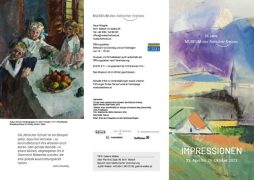Anton KOLIG, Group of children in front of the window, 1911, private collection (detail)
Archive of the Exhibition of 2023 – 25 years of the Nötscher Kreis Museum
IMPRESSIONS
Exhibition in the Museum of the Nötsch Circle from
April 23 to October 29, 2023
On May 16, 1998, the Museum of the Nötscher Kreis was opened in the municipality of Nötsch im Gailtal on the first floor of the house where the painter Franz Wiegele was born in order to make the oeuvre of the representatives of this group of artists accessible to the public, to document their lives and to provide an insight into their numerous connections to the art scene of their time. Since then, the Museum des Nötscher Kreises has been focusing on the significance, positioning, impact and sustainability of this group of painters in annually changing exhibitions. The special appeal of this loose group of painter friends, who were either born in Nötsch or moved here from abroad and chose this alpine village as their most important living and working environment despite long periods of absence and repeated stays abroad, lies above all in the diversity of expression and individuality of the protagonists.
They did not cultivate a similar conception of art or a uniform style, but rather very different painter personalities stood in a differentiated and changing relationship with each other, which was characterized by mutual inspiration and attraction as well as occasional tensions. What the representatives of the Nötsch circle had in common, however, was their enthusiasm for the sensual power of color and the high quality of their artistic work, with which they played a decisive role in shaping Austrian art in the first half of the 20th century.
Room 1
The oldest of the artists in the Nötsch circle was SEBASTIAN ISEPP, born in Nötsch in 1884. He began studying under Prof. Rudolf Bacher at the Academy of Fine Arts in Vienna in 1903 and underwent intensive stylistic development over a period of just over 10 years. Initially, Isepp's artistic intention was still to emphasize the atmospheric effect and depiction of various lighting moods, but he soon also incorporated ideas from the illustration graphics of the Vienna Secession. The painter also received a significant impulse from contemporary Scandinavian artists. The influence of Paul Gauguin and the Nabi group can also be seen in Isepp's oeuvre.
Sebastian Isepp was primarily a landscape painter. His preferred subjects included the impressive landscape forms and characteristic vegetation of the Gailtal valley. His extraordinary winter landscapes, which caused a sensation among his contemporaries and earned him the nickname "Schneeisepp", represented a special characteristic of the artist. Fascinated by the reduced colors of nature in winter, snow-covered forests, branches covered in hoarfrost and icy streams, his intense preoccupation with this genre led to an impressive tension between decorative linear surface effects, naturalistic realism and impasto brushwork.
In addition, the multi-talented artist was already a welcome guest in the progressive intellectual circles of early 20th century Vienna at a young age and his numerous contacts enabled the protagonists of the Nötsch circle to make interesting connections with well-known people in the cultural scene of the time. Isepp is also likely to have encouraged the artistic talent of his childhood friend FRANZ WIEGELE (1887-1944) from Nötsch and convinced him to study at the Academy of Fine Arts in Vienna. There, the two Nötschers became friends with ANTON KOLIG (1886-1950) from Neutitschein in Moravia, who married Wiegele's sister Katharina in 1911.
After 1918, Isepp shifted the focus of his work almost abruptly to restoring old works of art and eventually gave up his own painting production. He worked as a recognized restorer at the Kunsthistorisches Museum in Vienna until he was forced to emigrate in 1938 due to his wife Helene's Jewish origins. Sebastian Isepp died in London in 1954 at the age of seventy.
Room 2
In their work, Franz Wiegele and Anton Kolig focused primarily on the depiction of people. Both artists worked on portraiture throughout their lives, creating portraits of particular expressiveness. A selection of individual representative works of this subject will document their stylistic development and various biographical stages, such as Wiegele's "African Girl", a testimony to his trip to North Africa, which took him to Algeria and Morocco. In addition, the direct juxtaposition of these painters' works reveals their different approaches and artistic interpretations of the subject.
Room 3
Of particular relevance to the supra-regional significance of the "Nötscher Kreis" were Anton Kolig's art education ideas of his own painting school based on the model of a medieval workshop or a Renaissance artist's studio, which he attempted to realize in Nötsch. He wanted to found a collective in which he, as a master, would teach the basics of art to a small group of students and Franz Wiegele would supplement the training as an additional teacher. GERHART FRANKL (1901-1965) came to Nötsch as a painting student for the first time in 1920, followed by THEODOR HERZMANSKY (1900-1974) in 1921 and his school friend JOHANN WOLFGANG SCHAUKAL (1900-1981) in 1922. They worked together in the ballroom of the Michor inn, which they had rented as a studio. Through the study of the nude, they perfected their artistic understanding of the human body and discussed the relationship of color values to space on the basis of still lifes.
Room 4
In 1928, Anton Kolig accepted a professorship at the Württemberg Academy of Art in Stuttgart in order to be able to pursue his pedagogical vocation again. Among his students was the young Swabian ANTON MAHRINGER (1902-1974), who came to Nötsch for the first time as part of a study excursion. Fascinated by the striking alpine landscape of the Gailtal valley, he settled in this region in 1931 in order to develop an independent painterly formal language based on the diverse, charming landscape motifs. Initially still committed to an expressive, extremely impasto style of painting, his color palette soon brightened more and more. The depiction of light became increasingly important for his pictorial inventions, a theme that he shared with Franz Wiegele and from whom he received important impulses. In addition to landscapes, he also repeatedly devoted himself to portraits, mainly of family members or acquaintances from the local population. He captured the characteristic features of the models with great sensitivity.
.
Exhibition curator: Sigrid Diewald








